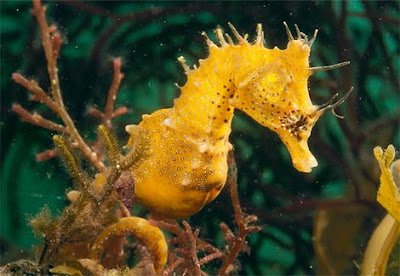
Anyone who has disturbed water at night, especially during a bloom, will have seen the intense bioluminescence produced (see picture above). But why this occurs has long been the subject of scientific query. Dinoflagellates are one planktonic group that bioluminesce, and this occurs due to deformation of their cell membrane caused by shear forces. This is often caused by intense water movement such as breaking waves or a predators swimming movements. One hypothesis is that this is a form of communication. This certainly seems to be the case when you consider that the light emitted by dinoflagellates has a maximum emission of around 475nm (blue-green), which produces light that is visible over long distances.
The authors in this paper propose that bioluminescence from the dinoflagellates serves to attract predators to the grazer. This 'burglar alarm' hypothesis argues that dinoflagellates become less attractive to grazers by increasing the risk of predation for the grazer. In other words, if a planktivore eats these dinoflagellates they will shine big bright lights saying 'food here' for predators within the area. Thus, dinoflagellates would be expected to be eliminated from the grazers diet.
Experiments to test this hypothesis were undertaken in glass jars containing dinoflagellates (those that bioluminesce, and those that don't), copepods (predators of dinoflagellates) and three-spined sticklebacks (predators of copepods). Thus, these experiments were able to directly test the predation rate on grazers, while feeding on dinoflagellates that either bioluminesce or don't. After 3.5 hrs both grazer and prey were removed from the jars, and the number of dinoflagellates remaining were counted. What they found was that the predation rate was almost doubled in the jars containing bioluminescent dinoflagellates. This shows that the mortality rates on copepods feeding on bioluminescent dinoflagellates increased, confirming the burglar alarm hypothesis.
It is important to note that the sticklebacks used in these experiments were never exposed to the experimental conditions. Thus, the light emitted by the dinoflagellates is a cue used in nature. Using signals to attract predators is not unique to dinoflagellates. Fear screams produced by birds and mammals is thought to be used for the same purpose.
Abrahams, M., & Townsend, L. (1993). BIOLUMINESCENCE IN DINOFLAGELLATES: A TEST OF THE BURGLAR ALARM HYPOTHESIS Ecology, 74 (1), 258-260 : 10.2307/1939521

The Burglar Alarm Hypothesis: The Role Of Bioluminescence







